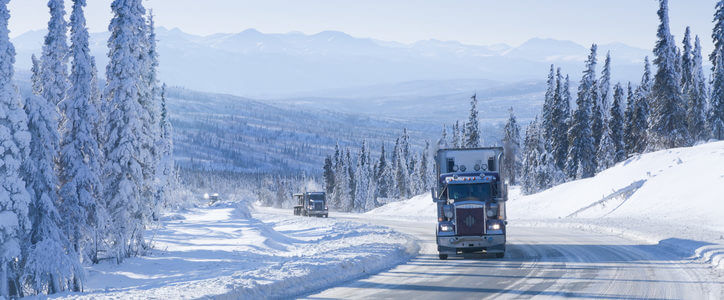Winter ushers in some of the most beautiful scenery that we see throughout the year. Imagine snow-coated trees and country hillsides. However, winter also ushers in the most dangerous time of the year to hit the roads and highways of the United States. This is especially true for larger vehicles, ranging from family SUVs to big-rig trucks.
According to the American Automobile Association (AAA) Foundation for Traffic Safety, frozen precipitation-covered roads and highways cause around 500,000 vehicle accidents and more than 2,000 fatalities each year. From tightly snow-packed rural roads to ice-glazed four-lane superhighways, winter weather conditions make it more difficult to operate a motor vehicle.
Make Maintenance a Priority
Getting ahead of the safety curve requires you to perform several checks before Old Man Winter visits the Northeast.
Check the Condition of Your Tires
Tire pressure decreases between one and two pounds for every 10-degree Fahrenheit drop in temperature. Every motor vehicle comes with an owner’s manual that recommends the optimal tire pressure for winter driving in the typical conditions where you operate a vehicle. Inflate your tires to the recommended level, and inspect the condition of the tread. Tires with worn tread tend to slip and slide in frozen precipitation, which increases the risk of getting involved in a winter weather collision.
Check the Condition of Your Brakes
Although the condition of brakes should be inspected every time a vehicle’s oil is changed, brakes should also be checked prior to the start of each winter season.
Operating a motor vehicle, particularly a large one, requires a braking system that allows you to stop in time while driving in any type of winter weather condition. Larger vehicles with poorly maintained brakes are highly vulnerable to becoming involved in an accident.
Stay on Top of the Latest Weather Forecasts
Winter weather can be a tricky thing to forecast accurately. Just a subtle change in a pattern can dramatically change what type of winter weather hits the area where you live. Nonetheless, understanding what type of winter weather possibly lurks in your neck of the woods can help you prepare your large vehicle for frozen precipitation action. Large vehicles are more susceptible to accidents because of high winds. From the Santa Ana winds that squeeze through the mountain passes of California to the hurricane-force gusts that cross the snow-swept upper plains, operating a large vehicle in winter can lead to a collision.
Clear Frozen Precipitation from Your Vehicle
Most people have seen or first handedly experienced unsafe driving conditions when someone neglects to remove frozen precipitation from the exterior of a car. It is important that motor vehicle operators diligently remove all excess ice and snow that collects on their automobile after a winter weather event. Since windshield wipers do not properly remove all frozen precipitation, it is recommended that an operator use a snow brush, starting at the top of the vehicle moving down to the windows and then hood and trunk last. This exercise will ensure a safer driving experience for not only the driver but for all others on the road. Interestingly, some states, such as Maine, New Hampshire and Connecticut have laws in place that require motorists to clean off their vehicles before driving on public roads.
Defensive Driving Should Prevail During Winter Conditions
The chances you might take during other times of the year do not make sense when operating a motor vehicle during winter weather conditions.
Slow and Steady Wins the Race
If you ever took a physics course, then you understand that the higher the velocity of an object, the stronger impact that object makes on other objects. When it comes to operating a motor vehicle, physics plays an important role in determining motor vehicle safety both for maintaining control of a vehicle on less than ideal roads as well as the result of a potential impact. You should slow your car down while driving on roads packed with frozen precipitation. To gain traction, accelerate your car slowly, and slow down when you change lanes or execute a pinpoint-controlled turn on a road or highway. The mantra “No Sudden Moves” applies, and it is wise to employ the concept of Straight Line Braking- braking when wheels are straight, rather than turned, which helps to maintain control.
Larger vehicles take more time to adjust to different speeds, especially when roads and highways are on the receiving end of a winter storm. Pay special attention to the conditions of ramps and bridges, which typically freeze over before roads and highways become slick. Bear in mind that the dynamics of an articulating truck may be different.
Minimize Distractions
Navigating a road or highway during winter requires your full attention when operating any type of motor vehicle. Navigating a larger vehicle on frozen-precipitation covered roads and highways deserves your undivided attention. Turn off your cell phone, as well as any other electronic device that can distract you from what lies ahead of your car. Operators of big rigs should turn down the volume of any communication device they use to stay in touch with their logistics center.
One more word of advice: Stay out of the way of snowplows when driving in winter weather conditions. Operators of larger vehicles often have trouble passing the machines that make their lives much easier on roads covered with ice and snow.
There for You: Acadia Insurance
At Acadia, we’re all about helping businesses throughout the Northeast thrive. Our mission is to provide superior service and product as close to you as possible, providing you with the backing you need to proceed with confidence.
We understand what you want most from your insurance is security and peace of mind. That means knowing you are backed by an insurance company who will support you every step of the way to help you protect your business.
With Acadia, not only can you get coverage tailored to your needs, but you will also receive support from dedicated claims professionals to guide you through the claim process in the event of a loss. That way, you know exactly what to expect. Knowing your claims professional by name and a hand shake – that’s “Closer Coverage”. Get to know more about how we work and find an agent near you.
Acadia Insurance is pleased to share this material with its customers. Please note, however, that nothing in this blog should be construed as legal advice or the provision of professional consulting services. This material is for general informational purposes only, and while reasonable care has been utilized in compiling this information, no warranty or representation is made as to accuracy or completeness.
Products and services are written or provided by subsidiaries and affiliates of W.R. Berkley Corporation. Not all products and services are available in every jurisdiction, and the precise coverage afforded by any insurer is subject to the actual terms and conditions of the policies as issued.




